Reed Flute Cave
- Shannon
- May 13
- 3 min read
Updated: Jul 31
The Palace of Natural Arts
The Reed Flute Cave, or Ludi Yan as it is known locally, has a fascinating history that stretches back over 1200 years, beginning during the Tang Dynasty. This 180 million year old karst cave complex, located in Guilin, has long been a symbol of natural beauty and historical significance. Its geological formations are a breathtaking testament to the slow, steady power of time, yet its human history is just as remarkable.

This colossal grotto is known as The Crystal Palace of the Dragon King
The cave’s written history can be traced to 792 AD, when inscriptions were made on its walls, offering an invaluable window into medieval Chinese culture. These inscriptions not only highlight the reverence ancient Chinese people held for the cave's majestic stalactites and stalagmites, but they also reflect the broader cultural and spiritual connections to nature that were central to Chinese philosophy and art during that period.
The Reed Flute Cave, also known as "The Palace of Natural Arts," is an expansive labyrinth of interconnected underground passages and chambers, formed over millions of years. This stunning natural wonder showcases a remarkable array of speleothems, including stalactites, stalagmites, cave pearls and flowstones. The intricate formations create a breathtaking underground landscape that highlights the artistic power of nature. The cave’s beauty is further enhanced by strategic lighting that illuminates its unique formations, casting vibrant colours that bring out the textures and shapes of the stone. Many of these formations have been given mythical Chinese names, inspired by folklore and nature, which transform the cave into a living tapestry of both geological marvels and mythological history.

The Reed Flute Cave is home to 77 ancient inscriptions, written in intricate calligraphy, that offer a fascinating glimpse into the lives, beliefs and culture of the people who once inhabited the region. These inscriptions, some dating back over a thousand years, reflect the deep connection the ancient Chinese had with the cave and their surroundings. One of the most poignant inscriptions is a poem that speaks to the timeless human desire for connection and expression, revealing the emotional and cultural depth of those who experienced the cave long ago.
The Reed Flute Cave was nearly forgotten for a thousand years before being rediscovered during World War II. As Japanese forces expanded their occupation across China and the bombing campaigns intensified, the cave’s extensive network of tunnels became a sanctuary for thousands of locals seeking safety. Amid the chaos, students continued their studies by lamplight, while monks are rumoured to have hidden ancient scrolls and sacred relics within the cave, using its hidden depths to protect these treasures from looting and destruction.

This mesmerising subterranean realm is a living canvas that showcases an ever evolving natural marvel. Recognising its significance as both a natural and cultural heritage site, the local community and governing authorities have taken steps to preserve and protect the cave. Its location within the broader Lijiang River Scenic Zone of Guilin further enhances its importance and the cave is now on the waiting list to receive UNESCO World Heritage status, reflecting its global cultural and geological value.

The cave’s name is derived from the reeds that grow at its entrance, which were traditionally used to make flutes
🗺️ Location
1 Ludi Road, Xiufeng District, Guilin City, China
🚆 How to get there
The Reed Flute Cave is located roughly 7 kilometers from downtown Guilin, or about a 20 minute drive depending on traffic. Taking a Didi taxi is the most convenient and hassle free option, typically costing around ¥20. Alternatively, you can catch local bus lines 3 or 213, which stop near the entrance and offer a more budget friendly, though slower, way to reach the site.
⭐ Attraction Info
The Reed Flute Cave is open to visitors from April to December between 7:30am - 6:00pm and from December to March between 8am - 5:30pm. Tickets cost ¥120 per person and can be purchased at the entrance or through major travel platforms. To fully appreciate the caves surreal beauty and take in the various formations and light displays, it’s best to allow at least an hour to explore at a relaxed pace. Guided tours are available in multiple languages, adding context to the cave’s natural history and the legends surrounding its fantastical shapes.
芦笛岩
Thanks for reading about the Reed Flute Cave. Check out more awesome destinations here!























